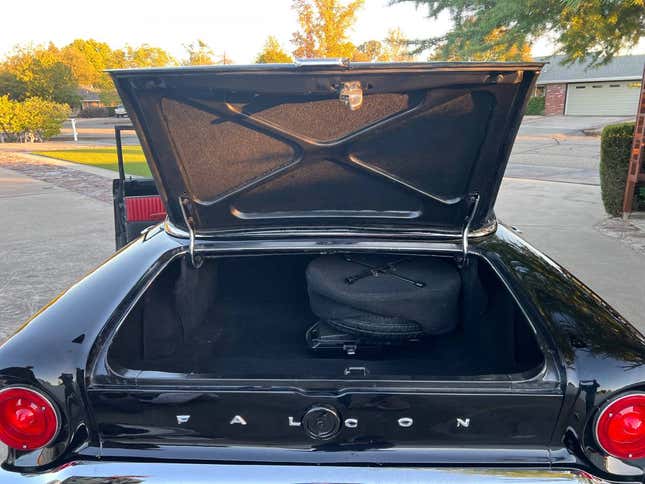At $16,500, Is This 1961 Ford Falcon Ready To Fly?

The OHV straight six in today’s Nice Price or No Dice Ford Falcon is a member of what is generally considered to be one of the most reliable engine families on the planet. Let’s see how reliably priced this classic compact is perceived.
I Need To Replace My Dying Volkswagen | What Car Should You Buy?
Showing great flexibility, the phrase “wear and tear” can alternatively be used to refer to either (A) a male stripper’s performance chaps or (B) to an item’s loss, damage, or depreciation resulting from ordinary use.
The 2004 Dodge Neon SRT-4 we looked at yesterday exhibited the latter, suffering both wear (its clutch) and tear (its driver’s seat upholstery). Such deprecation in the aesthetic and performance aspects had many of you calling out its $9,700 asking price as too high. In the end, that call went unanswered, resulting in a sizable 84 percent No Dice loss.
When General Motors decided to get serious about taking on the insurgency of smaller, more economical import cars in the late 1950s, the company pulled out all the stops for the effort. That led to a number of innovative designs like the air-cooled rear-engined Chevy Corvair and a four-cylinder, “Rope Drive” transaxle-motivated Pontiac Tempest.
The Ford Motor Company, seeing the same singular threat presented by the imports, simply created a more compact clone of its larger cars. The result was the Ford Falcon, introduced for the 1960 model year and featuring a sensible, flexible design that engendered a series of car and light truck models all on a single platform. For the Falcon, Ford leveraged the unit-body architecture that it had piloted with the 1958 Thunderbird and Lincoln Continental. It would serve under various successors and offshoots for the nearly two decades that would follow.

Ford had never really played the fin game as seriously as did GM and Chrysler, and as that styling trope was waning anyway by the time the ’60s rolled around, the new Falcon offered no such appendages. Instead, the Falcon’s design on the primary saloon and two-door models offered simple aerodynamics culminating in a pair of round tail lamp lenses in half-circle end caps that emulate a twin-engine jet’s exhaust. Clean body lines and a simple two-headlamp nose completed the first Falcon’s good looks.
For engines, the Falcon, in its first few years, was made available with a base 144 Cubic Inch Displacement OHV straight six or a larger 170 CID edition of the same motor. Later, a 260 CID “Challenger” V8 would be offered as an option for those seeking added oomph. The choice of six and eight-cylinder engines would accompany the Falcon’s unit chassis and suspension components in the creation of the model’s most famous off-shoot, the Ford Mustang, introduced in April of 1964.

This 1961 Ford Falcon Sedan looks to be an excellent example of the economy model modernized only by a set of fat radial tires mounted on handsome dog dish chrome steelies. According to the ad, the clean title car comes with just 15,000 miles on the clock. Considering that it has a new interior and a ton of mechanical refreshing (clutch, brakes, etc.), that may or may not have rolled over. It appears to be in such nice shape and of an age that its mileage might just be a moot point.

The black paint shines nicely, as does the modest accompaniment of chrome trim. The tinted rear door glass seems to be a miss, but that’s a simple enough thing to change if you agree. Behind that is a red and black interior that looks to have been fabulously restored. Up front are a pair of vinyl-upholstered bucket seats, an odd but welcome upscale inclusion on a car that seems otherwise poverty spec. An added gauge threatens knees below the dash, and a small tachometer perches precariously on an A-pillar outrigger, but otherwise, the cabin looks original and very tidy.

Under the hood lives the Ford straight-six, an engine with legendary longevity. The ad doesn’t note the “Mileage Maker” engine’s displacement, whether 144 CID or 170, and I can’t tell from the pictures either. Supposedly, there’s a code stamped on the buttress atop the road draft tube reading T, U, or N that denotes engine size, but that’s not readable here.
What we can tell is that the six is mated to a standard-equipment three-on-the-tree manual for extra mileage and nostalgic fun. Everything under the hood looks clean as a whistle, although somebody went overboard with the Ford Blue paint in there, spraying the battery hold down, fuel filter, and even the inside of the intake snorkel. Like the window tint, that all could be easily toned down.

But would any of us want to? The Falcon’s $16,500 asking price will probably be the deciding factor. Let’s decide that right now.
What do you think of this seemingly fabulous Ford and that $16,500 asking price? Does that feel like a good deal to fly like an eagle… er, Falcon? Or is that not in alignment with Ford’s original intention for this to be a very cheap and economical car?
You decide!
Sacramento, California, Craigslist, or go here if the ad disappears.
Help me out with NPOND. Hit me up at remslie@kinja.com and send me a fixed-price tip. Remember to include your Kinja handle.



